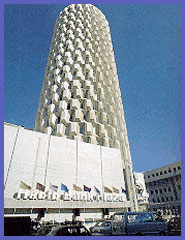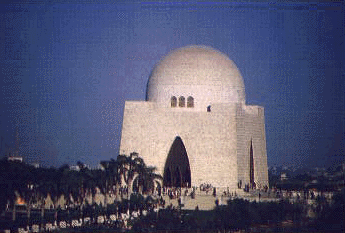Friday, July 10, 2009
| ||||||||||||||||
| ||||||||||||||||
| ||||||||||||||||
|
Thursday, July 9, 2009
KARACHI
| Karachi renowned as "The City of Lights" is the largest city of Pakistan. Karachi is the commercial capital of the country. It has representation of mostly all International Banks. Most of the International airlines fly here. All renowned airlines have offices in Karachi The city is vast in area. You can expect to see a large variety of modern and Colonial architecture. There are many beautiful mosques, Mausoleums, Churches and Libraries here. Bazaars of this city are the most attractive. It is has innumerable numbers of Shopping Beautiful shopping Malls. There are typical oriental style of bazaars with colors and narrow streets and also are the modern shopping centers offering a vast variety of goods. |  |
Pakistan Largest and Modern Airport Jinnah International Airport has also enhanced the city's beauty. The national museum of Pakistan is the most prestigious museums in Pakistan housing the artifacts from the old civilizations and the modern Pakistan movements relics. Karachi is the capital of the Sind province and It is a bustling center of commerce and industry, a big port . This beautiful city has sunny beaches at Sandspit, Hawkes Bay, Paradise Point, Cape Mount, Sunhera and Clifton. It has a lot to offer, including the National Museum, the Hill Park, a golf course, a squash complex and modern medical facilities.
| Brief History About hundred years agao this city was not a metropolitan city. A few fishermen lived in a small huts on the sunny creek. There was a pool of water on this barren piece of land which was known as Kalachi-jo-Kun. Kalachi was the name of fisherman whereas kun meant a deep kitch. |  |
Friday, July 3, 2009
Mecca Masjid
Mecca Masjid is near Charminar in the old city of Hyderabad is the biggest mosque in the entire south India.In the sheer size it ranks third in the country, next only to Jama Masjid in Delhi and the one at Gulbarga. Though Quli Qutb Shah laid the foundation stone for Mecca Masjid in 1614, it was Emperror Aurangzeb who completed its construction in 1687.Anestimated 10,000 devotees can offer prayers in the vast hall measuring 67 X 54 meters. Though Quli Qutb Shah , gave the name " Baitul Atiq " to this mosque ,a few bricks brought from Mecca ( and still displayed inside the mosque) perpetuated the name " Mecca Masjid " for this place of worship
in the entire south India.In the sheer size it ranks third in the country, next only to Jama Masjid in Delhi and the one at Gulbarga. Though Quli Qutb Shah laid the foundation stone for Mecca Masjid in 1614, it was Emperror Aurangzeb who completed its construction in 1687.Anestimated 10,000 devotees can offer prayers in the vast hall measuring 67 X 54 meters. Though Quli Qutb Shah , gave the name " Baitul Atiq " to this mosque ,a few bricks brought from Mecca ( and still displayed inside the mosque) perpetuated the name " Mecca Masjid " for this place of worship
CHARMINAR
Charminar is a monument located in the City of Hyderabad which is the capital city of the State of Andhra Pradesh in South India.Charminar is one of the most important landmarks of the city. The monument was built by Muhammad Quli Qutb Shah in 1591 to commemorate the eradication of plague, shortly after he had shifted his capital from Golconda to what now is known as Hyderabad. Legends tell that the emperor Quli Qutb Shah prayed for the end of plague and took the vow to build a mosque on that very place. He ordered the construction of the mosque which became popular as Charminar because of its four characteristic minarets. The top floor of the four-storeyed structure has a mosque which has 45 covered prayer spaces and some open space to accommodate more people in Friday prayers
built by Muhammad Quli Qutb Shah in 1591 to commemorate the eradication of plague, shortly after he had shifted his capital from Golconda to what now is known as Hyderabad. Legends tell that the emperor Quli Qutb Shah prayed for the end of plague and took the vow to build a mosque on that very place. He ordered the construction of the mosque which became popular as Charminar because of its four characteristic minarets. The top floor of the four-storeyed structure has a mosque which has 45 covered prayer spaces and some open space to accommodate more people in Friday prayers
Muhammad Quli Qutb Shah ,sultan of the Qutb Shahi dynasty, ruled from Hyderabad. The Charminar is a beautiful and impressive square monument, with each side measuring 20 meters, and each of the edges having a pointed high minaret.It derives its name from these four gracefully carved minarets which soar to a height of 48.7 m above the ground, commanding the landscape for miles around.
Charminar literally means 'Four Minars'. Each minaret has four stories, each looking like a delicately carved ring around the minaret. Every side opens into a plaza through giant arches, which overlook four major thoroughfares and dwarf other features of the building except the minarets. Each arch is 11 m wide and rises 20 m to the pinnacle from the plinth. Once upon a time each of these arches led to four royal roads. Each of the four arches has a clock which were put up in 1889.
There are two galleries within the Charminar, one over another, and above those a terrace that serves as a roof, bordered with a stone balcony. It is vaulted underneath and appears like a dome. There is a large table raised seven or eight feet from the ground with steps to go up to it. Nothing in the town seems so lovely as the outside of that building
A thriving market still lies around the Charminar attracting people and merchandise of every description. In its heyday, the Charminar market had some 14,000 shops, a unique conglomeration of a grand oriental bazaar.The whole market around the Charminar is crowded with shops which sell glass bangles in rainbow colours.
Unlike Taj Mahal, the fluted minarets of Charminar are built into the main structure. Inside the four-storied minarets 149 winding steps guide the visitor to the upper floor, the highest point one can reach, and providing a panoramic view of the city. There are 45 prayer spaces with a large open space in front to accommodate more for Friday prayers.
Built with granite and lime mortar, Charminar is a fine example of the Cazia style of architecture. The Charminar looks spectacular particularly in the nights when it is illuminated.
GOLKONDA FORT
Golkonda is a ruined city and fortress 11 km west of the city of Hyderabad, Andhra Pradesh state, India. The city and fortress are built on a granite hill that is 120 meters high and is surrounded by massive crenellated ramparts. The beginnings of the fort date to the 1143,when the Hindu
Kakatiya dynasty ruled the area. The Kakatiyas were followed by the state
of Warangal, which was later conquered by the Muslim Bahmani Sultanate. Golkonda consists of four distinct forts with a 10 km long outer wall having 87 semi circular bastions; some still mounted with cannons, eight gateways, four drawbridges and number of royal apartments & halls, temples, mosques, magazines, stables etc, inside. The lowest of these is the outermost enclosure into which we enter by the 'Fateh Darwaza' ( Victory gate, so called after Aurangzeb’s triumphant army marched in through this gate ) studded with giant iron spikes ( to prevent elephants from battering them down ) near the south
-eastern corner.
At Fateh Darwaza can be experienced the fantastic acoustic effects, characteristic of the engineering marvels at Golkonda. A hand clap at a certain point below the dome at the entrance reverberates and can be heard clearly at the 'Bala Hisar' pavilion, the highest point almost a kilometre away. This acted as the warning note to residents in case of danger.
The tombs of the Qutb Shahi sultans lie about one kilometer north of
Golkonda's outer wall. These graceful structures are made of beautifully
carved stonework, and surrounded by landscaped gardens. Golkonda fort
overlooking HyderabadThe fortress city within the walls was famous for its diamond trade, and many famed diamonds including the Koh-i-noor, the Regent Diamond and the Hope are said to have come from here. The wealth of the Golkonda mines enriched the ruling Nizams of Hyderabad, which ruled the area from their independence from the Mughals in1724 to1948 ,when Hyderabad was annexed by India to become an Indian state. Hyderabad state was broken up in 1956, and Golkonda became part of Andhra Pradesh state.












